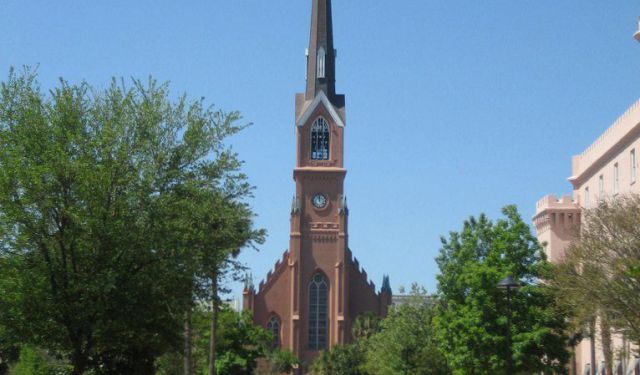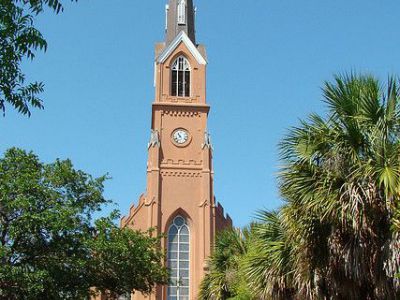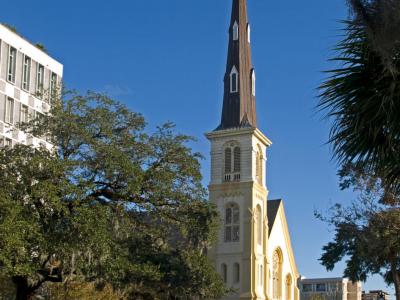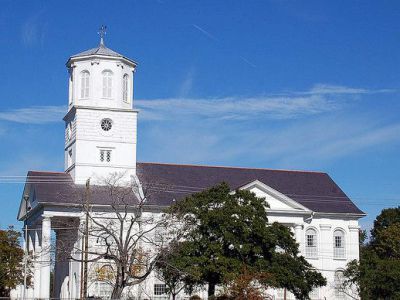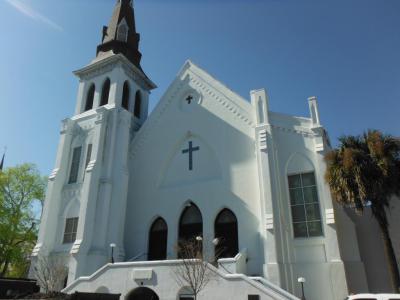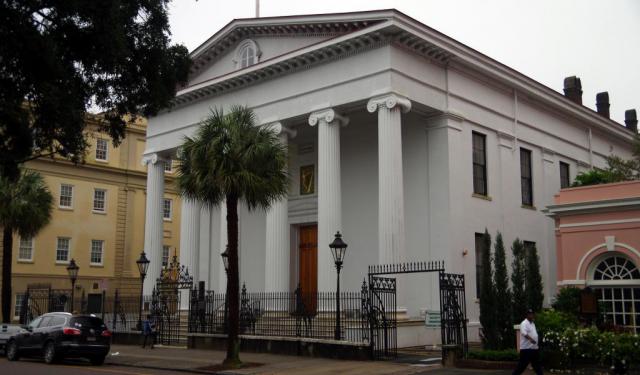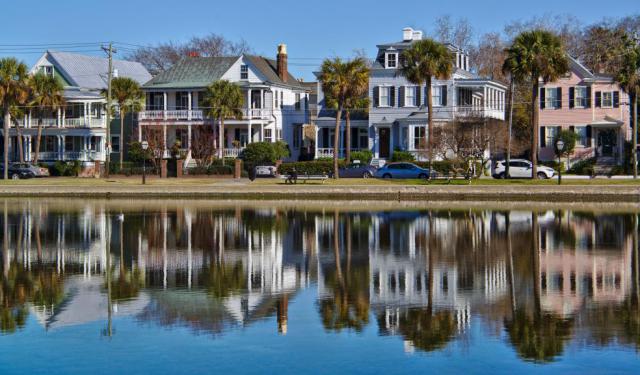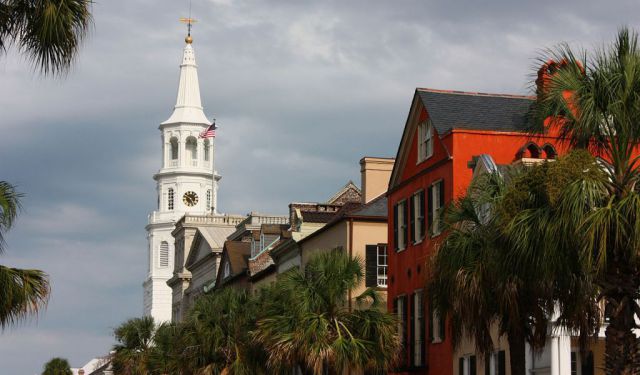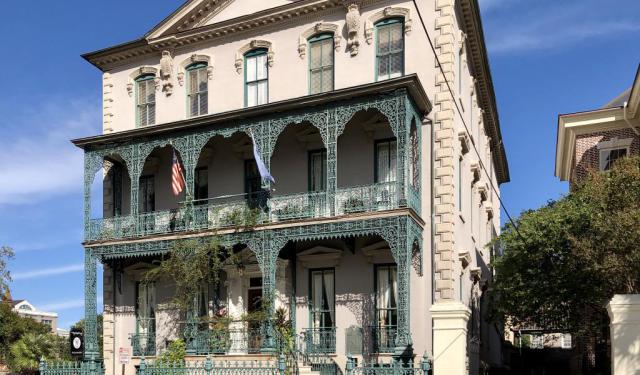Downtown Historical Churches Tour (Self Guided), Charleston
Charleston, South Carolina, is also sometimes called the “Holy City.” This is due to the large number of churches found here. Needless to say, the most fascinating of them are concentrated in the Downtown area, each with its unique charm and significance.
Among such temples of distinction is Saint Matthew's Church, an enduring symbol of Charleston's German Lutheran community. Its Gothic Revival architecture and intricate stained glass windows are a testament to the craftsmanship of the 19th century.
On the other hand, Citadel Square Baptist Church exudes Southern charm with its picturesque white-and-yellow façade and steeple. This Baptist congregation has been a beacon of faith and community for over 150 years, welcoming worshipers from all walks of life.
Second Presbyterian Church is a striking example of Greek Revival architecture, with its majestic columns and elegant design. It has been a center of Presbyterian worship and community engagement since its founding in the early 1800s.
Mother Emanuel AME Church holds a special place in American history as the site of a tragic mass shooting in 2015. Despite this dark chapter, it continues to serve as a symbol of resilience and faith, fostering unity and healing within the African-American community.
Saint John's Reformed Episcopal Church, with its Gothic-style appearance, is another architectural gem that adds to the city's ecclesiastical diversity. It provides a serene space for reflection and worship amidst the busy downtown Charleston.
As you explore these historic places of worship, you can't help seeing them as a unique window into the city's soul. So, if you wish to connect with Charleston's deep-rooted spiritual and cultural heritage, this self-guided tour may help you discover the stories and history held within these sacred walls.
Among such temples of distinction is Saint Matthew's Church, an enduring symbol of Charleston's German Lutheran community. Its Gothic Revival architecture and intricate stained glass windows are a testament to the craftsmanship of the 19th century.
On the other hand, Citadel Square Baptist Church exudes Southern charm with its picturesque white-and-yellow façade and steeple. This Baptist congregation has been a beacon of faith and community for over 150 years, welcoming worshipers from all walks of life.
Second Presbyterian Church is a striking example of Greek Revival architecture, with its majestic columns and elegant design. It has been a center of Presbyterian worship and community engagement since its founding in the early 1800s.
Mother Emanuel AME Church holds a special place in American history as the site of a tragic mass shooting in 2015. Despite this dark chapter, it continues to serve as a symbol of resilience and faith, fostering unity and healing within the African-American community.
Saint John's Reformed Episcopal Church, with its Gothic-style appearance, is another architectural gem that adds to the city's ecclesiastical diversity. It provides a serene space for reflection and worship amidst the busy downtown Charleston.
As you explore these historic places of worship, you can't help seeing them as a unique window into the city's soul. So, if you wish to connect with Charleston's deep-rooted spiritual and cultural heritage, this self-guided tour may help you discover the stories and history held within these sacred walls.
How it works: Download the app "GPSmyCity: Walks in 1K+ Cities" from Apple App Store or Google Play Store to your mobile phone or tablet. The app turns your mobile device into a personal tour guide and its built-in GPS navigation functions guide you from one tour stop to next. The app works offline, so no data plan is needed when traveling abroad.
Downtown Historical Churches Tour Map
Guide Name: Downtown Historical Churches Tour
Guide Location: USA » Charleston (See other walking tours in Charleston)
Guide Type: Self-guided Walking Tour (Sightseeing)
# of Attractions: 5
Tour Duration: 1 Hour(s)
Travel Distance: 1.3 Km or 0.8 Miles
Author: alice
Sight(s) Featured in This Guide:
Guide Location: USA » Charleston (See other walking tours in Charleston)
Guide Type: Self-guided Walking Tour (Sightseeing)
# of Attractions: 5
Tour Duration: 1 Hour(s)
Travel Distance: 1.3 Km or 0.8 Miles
Author: alice
Sight(s) Featured in This Guide:
- St. Matthew's Lutheran Church
- Citadel Square Baptist Church
- Second Presbyterian Church
- Mother Emanuel AME Church
- St. John's Reformed Episcopal Church
1) St. Matthew's Lutheran Church
The significant influx of German immigrants to Charleston during the first half of the 19th century prompted the city's second-oldest Lutheran congregation to embark on a major expansion of their place of worship. The result was this magnificent Gothic-style church, distinguished by its lofty German-crafted stained-glass windows, which was completed in 1872. Its crowning glory was the towering 297-foot spire, surpassing any other in the state in height.
However, in a dramatic incident in 1965, a fire engulfed the church, causing the spire to collapse onto the street below. Remarkably, the steeple's point pierced the sidewalk just to the left of the church's front door. To this day, that steeple point remains encased in concrete and is commemorated by a plaque, symbolizing the congregation's resilience and determination to restore the architectural treasure.
However, in a dramatic incident in 1965, a fire engulfed the church, causing the spire to collapse onto the street below. Remarkably, the steeple's point pierced the sidewalk just to the left of the church's front door. To this day, that steeple point remains encased in concrete and is commemorated by a plaque, symbolizing the congregation's resilience and determination to restore the architectural treasure.
2) Citadel Square Baptist Church
Founded in 1854 by twelve members from First Baptist Church, who were later joined by congregants from other Baptist churches in Charleston, this merged congregation wasted no time in constructing a new church building. The architects responsible for this new structure, Edward C. Jones and Francis D. Lee designed it in what was described as a "pure Norman" style, inspired by the Romanesque architecture prevalent in France. Interestingly, their design predates the more famous work in this style by Henry Hobson Richardson.
The exterior features a massive gable roof facing Meeting Street, adorned with arched entries topped by elaborate Romanesque windows, including a stunning rose window. Unfortunately, the 224-foot spire was toppled by a hurricane in 1885; its replacement, a shorter late-Victorian version of the original, had to be replaced again following damage from Hurricane Hugo. In 1990, the congregation raised funds to restore the steeple to its original height, making some concessions in design to incorporate post-1885 alterations.
Inside the church, ribbed vaulting and plaster bosses adorn the ceilings, including the pulpit area, where an alcove was originally wainscoted in oak. At one point, the interior was painted to imitate stone.
The exterior features a massive gable roof facing Meeting Street, adorned with arched entries topped by elaborate Romanesque windows, including a stunning rose window. Unfortunately, the 224-foot spire was toppled by a hurricane in 1885; its replacement, a shorter late-Victorian version of the original, had to be replaced again following damage from Hurricane Hugo. In 1990, the congregation raised funds to restore the steeple to its original height, making some concessions in design to incorporate post-1885 alterations.
Inside the church, ribbed vaulting and plaster bosses adorn the ceilings, including the pulpit area, where an alcove was originally wainscoted in oak. At one point, the interior was painted to imitate stone.
3) Second Presbyterian Church
Initially established to serve the city's growing Presbyterian community, this church, founded in 1809, has played a prominent role in Charleston's religious landscape and stands as an enduring architectural representation of the Reformed Faith. It is the fourth oldest surviving original church in the city, following Saint Michael's, the current Unitarian Church, and Old Bethel Methodist Church.
Its Classic Revival sanctuary, though more elaborate than the colonial-era meeting houses, upholds the simplicity characteristic of Presbyterian tradition. A prominent pulpit underscores the sermon's central importance in worship, while the placement of the communion table within the congregation symbolizes the belief in the priesthood of all believers. Additionally, the presence of the baptismal font among the congregation signifies their commitment to nurturing the spiritual growth of the baptized.
Remarkable for its Palladian stained glass window, the church's architecture conveys inclusivity, portraying Jesus Christ alongside individuals of diverse ages, genders, races, and professions. Inside the sanctuary, a bas-relief, meticulously restored after Hurricane Hugo, showcases various symbolic elements and references from the Bible.
Meanwhile, the surrounding graveyard narrates the stories of numerous generations of church members, including veterans, college founders, ministers, and community leaders. Notably, this burial ground is characterized by a significant number of child interments, reflecting historical challenges such as malnutrition and disease.
Its Classic Revival sanctuary, though more elaborate than the colonial-era meeting houses, upholds the simplicity characteristic of Presbyterian tradition. A prominent pulpit underscores the sermon's central importance in worship, while the placement of the communion table within the congregation symbolizes the belief in the priesthood of all believers. Additionally, the presence of the baptismal font among the congregation signifies their commitment to nurturing the spiritual growth of the baptized.
Remarkable for its Palladian stained glass window, the church's architecture conveys inclusivity, portraying Jesus Christ alongside individuals of diverse ages, genders, races, and professions. Inside the sanctuary, a bas-relief, meticulously restored after Hurricane Hugo, showcases various symbolic elements and references from the Bible.
Meanwhile, the surrounding graveyard narrates the stories of numerous generations of church members, including veterans, college founders, ministers, and community leaders. Notably, this burial ground is characterized by a significant number of child interments, reflecting historical challenges such as malnutrition and disease.
4) Mother Emanuel AME Church
The African Methodist Episcopal Church originated in 1787 in Philadelphia with the establishment of the Free African Society, which was rooted in the doctrines of Methodism and the teachings of John Wesley. A similar organization emerged in Charleston in 1791 under the leadership of Rev. Morris Brown, a free black preacher associated with another Methodist church in the city. This display of autonomy by black members led to a separation from the Methodists, giving rise to the foundation of three black churches in Charleston, collectively known as the Bethel Circuit. The congregation of Emanuel A.M.E. Church is one of the churches born from this movement.
Initially, the church was located in the Hampstead neighborhood on the city's east side and boasted a membership of 1,000 by 1818. Just four years later, in 1822, Denmark Vesey, a skilled carpenter who had purchased his freedom, devised plans for a slave insurrection within the premises. News of the planned rebellion leaked, resulting in the execution of Vesey and some of his supporters, and the burning of the Hampstead church. By 1834, the state legislature in South Carolina ordered the closure of all black churches.
Following the Denmark Vesey incident, some of the congregation returned to white churches, while others continued their African church traditions clandestinely. In 1865, after years of underground worship, the congregation resurfaced, now numbering 3,000 members. The current church building, completed in 1891, still retains the original gas lamps that line the sanctuary. With seating for 2,500 individuals, is the largest African-American congregation in Charleston today.
Initially, the church was located in the Hampstead neighborhood on the city's east side and boasted a membership of 1,000 by 1818. Just four years later, in 1822, Denmark Vesey, a skilled carpenter who had purchased his freedom, devised plans for a slave insurrection within the premises. News of the planned rebellion leaked, resulting in the execution of Vesey and some of his supporters, and the burning of the Hampstead church. By 1834, the state legislature in South Carolina ordered the closure of all black churches.
Following the Denmark Vesey incident, some of the congregation returned to white churches, while others continued their African church traditions clandestinely. In 1865, after years of underground worship, the congregation resurfaced, now numbering 3,000 members. The current church building, completed in 1891, still retains the original gas lamps that line the sanctuary. With seating for 2,500 individuals, is the largest African-American congregation in Charleston today.
5) St. John's Reformed Episcopal Church
In 1873, the Reformed Episcopal denomination was established when it separated from the Protestant Episcopal Church due to the latter's refusal to train and ordain black ministers. The movement found its way to the Charleston area the following year when Reverend Peter Stevens, a white Confederate Army veteran, began organizing groups of black freedmen throughout the Lowcountry.
One of these groups convened in a house, and it was there that Saint John's congregation took shape in 1906. In a city still grappling with its deep-seated racism, the black parishioners sought solace and community through worship. However, it wasn't until 1971 that Saint John's found a new home in this Gothic Revival building on Anson Street, a structure of historical significance in its own right.
Constructed in 1850 by black freedmen and slaves who were part of the Presbyterian community, the church became the site of a significant revival in Charleston in 1857. At a time when the nation was on the brink of its bloodiest conflict, blacks and whites, slaves and freedmen, came together in this church to pray and sing hymns side by side.
In the 1880s, the church underwent renovations that added transepts, a Gothic frame ceiling, and 14 stained glass windows. According to records from the Historic Charleston Foundation, many of the church's interior features, including stenciled decorations and gilded Gothic elements, have been preserved by the Saint John's congregation.
On the church grounds, there is a beautifully landscaped garden dedicated to honoring church member Philip Simmons, a renowned Charleston ironworker. Simmons was the designer of the "Heart Gate" that serves as the entrance to this garden.
One of these groups convened in a house, and it was there that Saint John's congregation took shape in 1906. In a city still grappling with its deep-seated racism, the black parishioners sought solace and community through worship. However, it wasn't until 1971 that Saint John's found a new home in this Gothic Revival building on Anson Street, a structure of historical significance in its own right.
Constructed in 1850 by black freedmen and slaves who were part of the Presbyterian community, the church became the site of a significant revival in Charleston in 1857. At a time when the nation was on the brink of its bloodiest conflict, blacks and whites, slaves and freedmen, came together in this church to pray and sing hymns side by side.
In the 1880s, the church underwent renovations that added transepts, a Gothic frame ceiling, and 14 stained glass windows. According to records from the Historic Charleston Foundation, many of the church's interior features, including stenciled decorations and gilded Gothic elements, have been preserved by the Saint John's congregation.
On the church grounds, there is a beautifully landscaped garden dedicated to honoring church member Philip Simmons, a renowned Charleston ironworker. Simmons was the designer of the "Heart Gate" that serves as the entrance to this garden.
Walking Tours in Charleston, South Carolina
Create Your Own Walk in Charleston
Creating your own self-guided walk in Charleston is easy and fun. Choose the city attractions that you want to see and a walk route map will be created just for you. You can even set your hotel as the start point of the walk.
French Quarter Walking Tour
A historic district in downtown Charleston, The French Quarter is named so for the high concentration of French merchants that once lived in the area and left their mark on it. The name was coined in 1973, when preservation efforts began for warehouse buildings on the Lodge Alley block. That same year the district was added to the National Register of Historic Places.
The busy neighbourhood... view more
Tour Duration: 1 Hour(s)
Travel Distance: 1.7 Km or 1.1 Miles
The busy neighbourhood... view more
Tour Duration: 1 Hour(s)
Travel Distance: 1.7 Km or 1.1 Miles
Harleston Village Walking Tour
Founded in the 18th century, the historic Harleston Village is a charming neighborhood in Charleston, South Carolina. The rich past and vibrant present of this area make it a popular destination for tourists.
At the heart of Harleston Village lies the College of Charleston, an esteemed institution of higher learning, established in 1770, adding a great deal of academic flair to the... view more
Tour Duration: 2 Hour(s)
Travel Distance: 2.3 Km or 1.4 Miles
At the heart of Harleston Village lies the College of Charleston, an esteemed institution of higher learning, established in 1770, adding a great deal of academic flair to the... view more
Tour Duration: 2 Hour(s)
Travel Distance: 2.3 Km or 1.4 Miles
Charleston Introduction Walking Tour
A popular tourist destination and a major port city in South Carolina, Charleston is fit to impress anyone with its Southern charm, friendliness, and rich history. Founded in 1670 as Charles Town, honoring King Charles II of England, this was the first comprehensively planned town in America.
The city's significance in American history is tied to its role as a key slave trading port. The... view more
Tour Duration: 2 Hour(s)
Travel Distance: 2.8 Km or 1.7 Miles
The city's significance in American history is tied to its role as a key slave trading port. The... view more
Tour Duration: 2 Hour(s)
Travel Distance: 2.8 Km or 1.7 Miles
Historical Houses Tour
Charleston is steeped in history. Walking the colorful, narrow cobblestone streets of one of America's oldest towns, with its stunningly preserved colonial homes, you can see its story play out before your eyes practically everywhere you turn. Indeed, Charleston is among the most celebrated places in the U.S. to explore fine examples of American architecture and its progression through time.
... view more
Tour Duration: 2 Hour(s)
Travel Distance: 4.3 Km or 2.7 Miles
... view more
Tour Duration: 2 Hour(s)
Travel Distance: 4.3 Km or 2.7 Miles
The Most Popular Cities
/ view all
